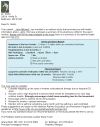Factors associated with completion of a behavioral intervention for caregivers of urban children with asthma
- PMID: 22991952
- PMCID: PMC3773483
- DOI: 10.3109/02770903.2012.721435
Factors associated with completion of a behavioral intervention for caregivers of urban children with asthma
Abstract
Background: Rates of preventive follow-up asthma care after an acute emergency department (ED) visit are low among inner-city children. We implemented a novel behavioral asthma intervention, Pediatric Asthma Alert (PAAL) intervention, to improve outpatient follow-up and preventive care for urban children with a recent ED visit for asthma.
Objective: The objective of this article is to describe the PAAL intervention and examine factors associated with intervention completers and noncompleters.
Methods: Children with persistent asthma and recurrent ED visits (N = 300) were enrolled in a randomized controlled trial of the PAAL intervention that included two home visits and a facilitated follow-up visit with the child's primary care provider (PCP). Children were categorized as intervention completers, that is, completed home and PCP visits compared with noncompleters, who completed at least one home visit but did not complete the PCP visit. Using chi-square test of independence, analysis of variance, and multiple logistic regression, the intervention completion status was examined by several sociodemographic, health, and caregiver psychological variables.
Results: Children were African-American (95%), Medicaid insured (91%), and young (aged 3-5 years, 56%). Overall, 71% of children randomized to the intervention successfully completed all home and PCP visits (completers). Factors significantly associated with completing the intervention included younger age (age 3-5 years: completers, 65.4%; noncompleters, 34.1%; p < .001) and having an asthma action plan in the home at baseline (completers: 40%; noncompleters: 21%; p = .02). In a logistic regression model, younger child age, having an asthma action plan, and lower caregiver daily asthma stress were significantly associated with successful completion of the intervention.
Conclusions: The majority of caregivers of high-risk children with asthma were successfully engaged in this home and PCP-based intervention. Caregivers of older children with asthma and those with high stress may need additional support for program completion. Further, the lack of an asthma action plan may be a marker of preexisting barriers to preventive care.
Trial registration: ClinicalTrials.gov NCT00860418.
Conflict of interest statement
Declaration of Interest
The authors report no conflicts of interest. The authors alone are responsible for the content and writing of this article. This study was supported by the National Institute of Nursing Research, NIH (NR010546), and is registered with clinicaltrials.gov, registration number NCT00860418.
Figures
References
-
- Bloom B, Dey AN. Summary health statistics for U.S. children: National Health Interview Survey, 2004. National Center for Health Statistics. Vital Health Statistics. 2006;10(227):4–5. - PubMed
-
- Akinbami LJ, Moorman JE, Liu X. Asthma prevalence, health care use and mortality: United States, 2005–2009. Natl Health Stat Rep. 2011;12(32):1–14. - PubMed
-
- Centers for Disease Control (CDC) National surveillance for asthma—United States, 1980–2004. MMWR. 2007;56(SS09):1–14. 18–54. - PubMed
-
- Stanford R, McLaughlin T, Okamoto LJ. The cost of asthma in the emergency department and hospital. Am J Respir Crit Care. 1999;160:211–215. - PubMed



